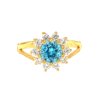- Konbuyu başlatan
- #1
- 5 Kas 2022
- 4
- 0
- 1
- 24
There are many types of beautiful gold, but have you ever stopped to think about the difference between yellow, white, and rose gold? Learn more about what those gold rings on your finger mean!
yellow
The purity of gold is measured in karats. If gold is 100% pure, then it is 24 karat gold (24K) and is a bright 22ct gold jewellery yellow color. In its purest form, yellow gold is soft, ductile, and malleable, and it scratches easily, making it unsuitable for jewelry wear. Consequently, it must be alloyed with base metals to give it strength. Generally copper is most commonly used as the base metal, but silver or palladium is also used. The amount of base metal used in the alloy dictate the number of karats:
The term white gold is used very loosely in the fine jewelry industry to 22ct gold rings describe karat gold alloys with a whitish tinge. the term "white" covers a large spectrum of colors that include pale yellow, pale rose, and tinted brown; the jewelry industry often hides these off-white colors with rhodium plating, a white and reflective metal that provides an excellent protective coating.
White gold is an alloy of gold and at least one white metal, usually silver, copper, manganese, palladium, or nickel. Nickel ladies gold ring and palladium act as primary bleaching agents for gold; zinc acts as a secondary bleaching agent to counter-balance the color of copper.
White gold's properties vary depending on the metals and proportions used in the alloy: a nickel alloy is stronger and therefore better for rings and pins, while palladium alloys are softer and better for gemstone settings.
fr more detail to visit our website >>> https://www.a1jewellers.com/
yellow
The purity of gold is measured in karats. If gold is 100% pure, then it is 24 karat gold (24K) and is a bright 22ct gold jewellery yellow color. In its purest form, yellow gold is soft, ductile, and malleable, and it scratches easily, making it unsuitable for jewelry wear. Consequently, it must be alloyed with base metals to give it strength. Generally copper is most commonly used as the base metal, but silver or palladium is also used. The amount of base metal used in the alloy dictate the number of karats:
- 18K - 18 parts gold, 6 parts other metals by weight (75% pure)
- 14K - 14 parts gold, 10 parts other metals by weight (58.3% pure)
- 10K - 10 parts gold, 14 parts other metals by weight (41.7% pure)
The term white gold is used very loosely in the fine jewelry industry to 22ct gold rings describe karat gold alloys with a whitish tinge. the term "white" covers a large spectrum of colors that include pale yellow, pale rose, and tinted brown; the jewelry industry often hides these off-white colors with rhodium plating, a white and reflective metal that provides an excellent protective coating.
White gold is an alloy of gold and at least one white metal, usually silver, copper, manganese, palladium, or nickel. Nickel ladies gold ring and palladium act as primary bleaching agents for gold; zinc acts as a secondary bleaching agent to counter-balance the color of copper.
White gold's properties vary depending on the metals and proportions used in the alloy: a nickel alloy is stronger and therefore better for rings and pins, while palladium alloys are softer and better for gemstone settings.
fr more detail to visit our website >>> https://www.a1jewellers.com/
Ekli dosyalar
-
81 KB Görüntüleme: 0


